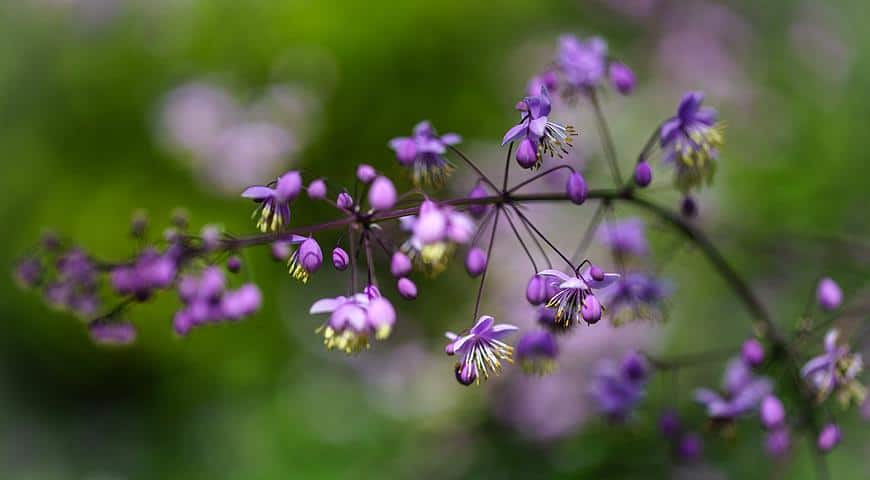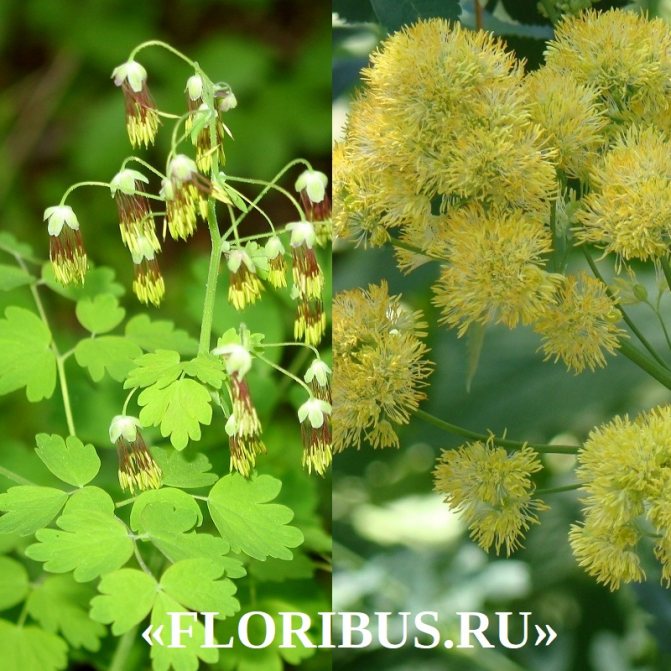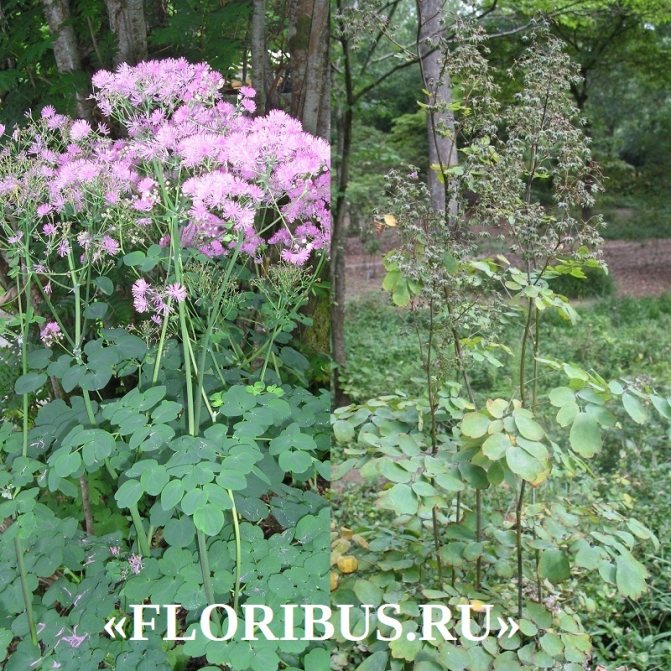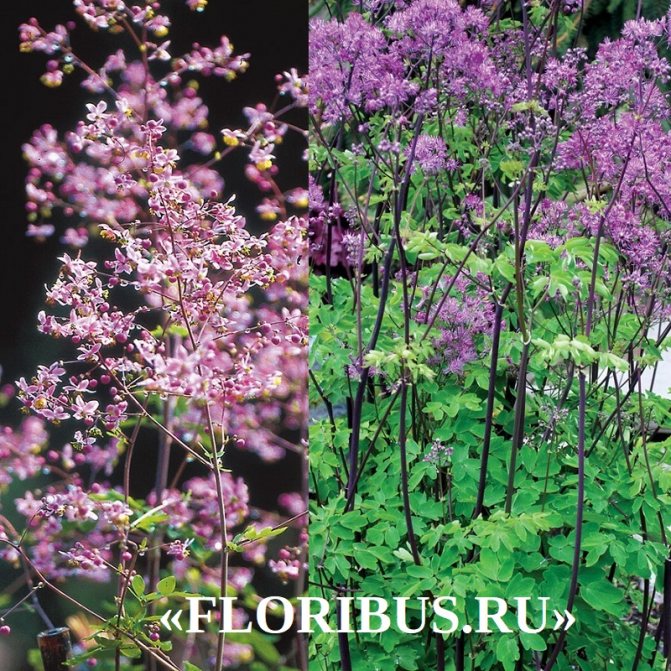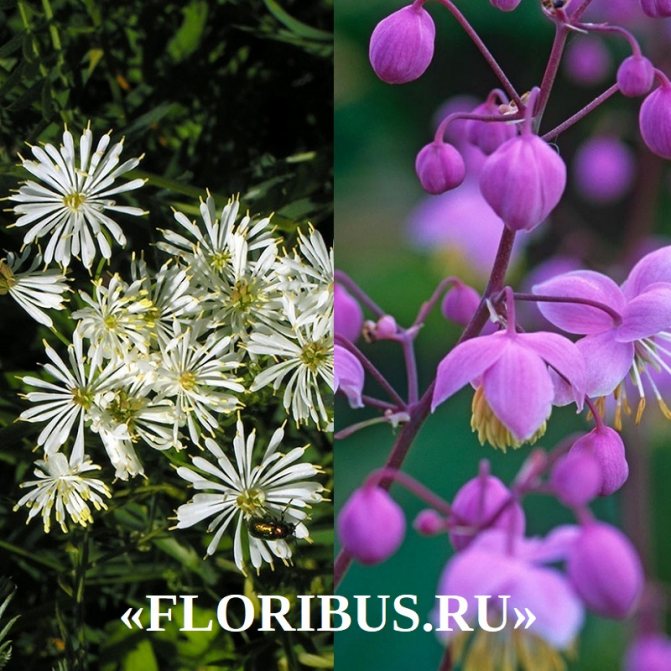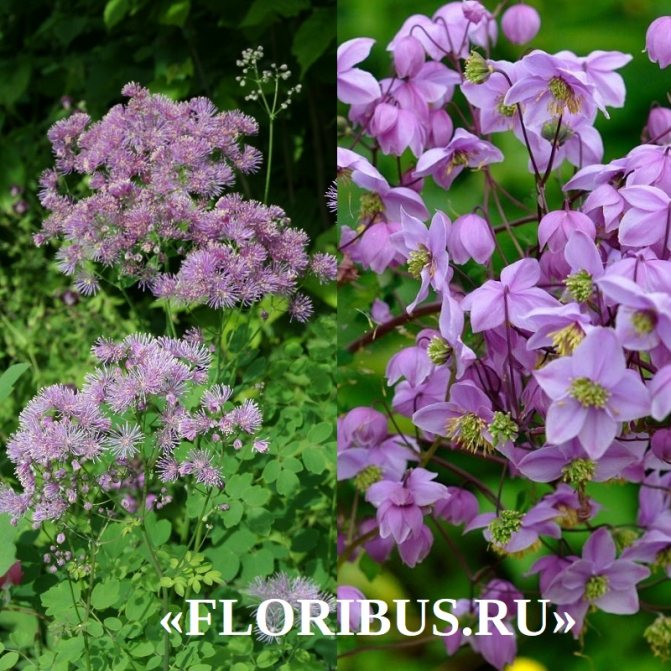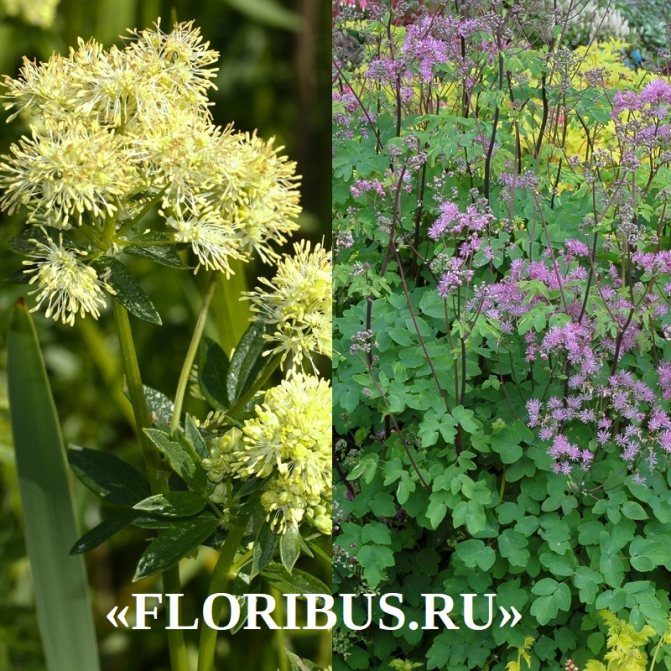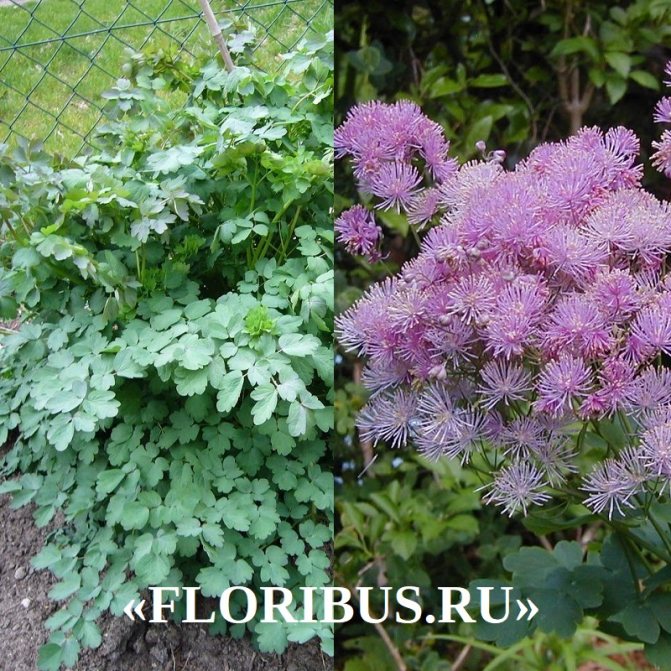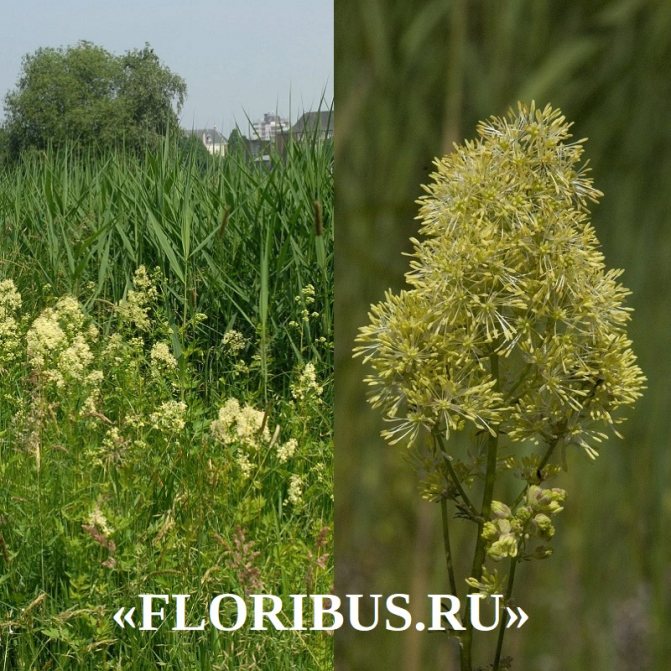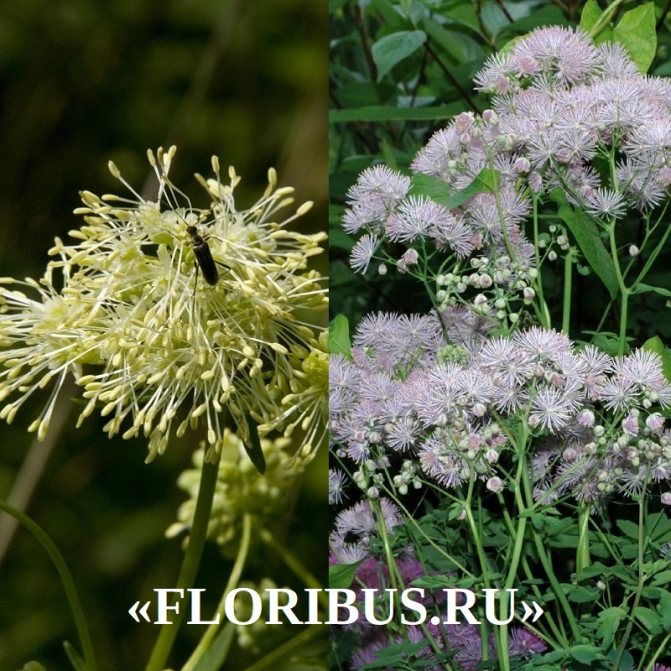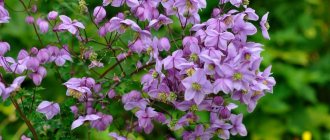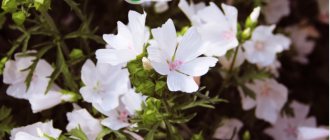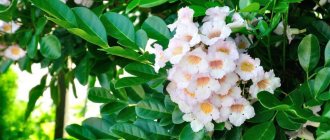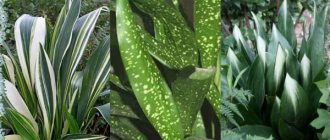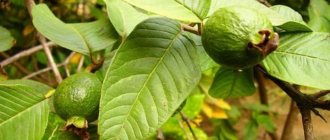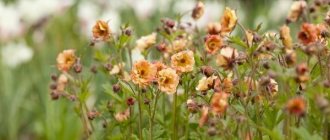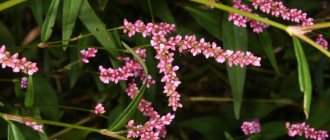Tall basilists
Since the giants are the most noticeable, then let's start with them.
Basil
The ancient inhabitant of our gardens Basil water-bearing (Thalictrum aquilegifolium)
just not a kid. Well-developed bushes in suitable conditions (rich moist soil, light shading) reach 180 cm. During flowering, when fluffy clouds of inflorescences hover above the bush, they are very effective. The foliage is good from the moment of regrowth to autumn, and if the inflorescences are not cut off, then you will get abundant self-seeding with different options for flower colors - from white to all shades of lilac and pink tones. There are selected forms - for example,
Thunder Cloud
with deep purple, almost purple flowers. The bush is more compact, it grows up to 120 cm, it should be propagated only vegetatively, since the varietal characteristics in the seedlings are not repeated.
European view light basil (Thalictrum lucidum)
has dense and shiny carved leaves that appear leathery. The flower clouds are creamy and white, the height of strong stems is 150-180 cm.
Basil yellow (Thalictrum flavum)
differs from the previous one in wider leaf lobes and light yellow large and branched fluffy inflorescences. The bushes are powerful, above 2 m. Both bloom in June, simultaneously with the basil aquifer. These plants are monumental and spectacular, but perhaps you would like a basil of a more garden-like, not so natural appearance, in a word, some kind of unusualness, zest.
Please - this is the form Basil Glaukum
yellow with bright gray, almost blue leaves
(Thalictrum flavum ssp. Glaucum or Thalictrum glaucum).
It is just as large, with age it becomes more beautiful and interesting already in early spring, when bright abundant foliage appears.
Variety Illuminator
has one more feature - the leaves are yellow at the time of regrowth. Variety
Silver Sparkler
has variegated leaves with white strokes and stripes. However, one can argue about their decorative advantages - the plant is quite impressive even without these features. In addition, these varieties are deprived of that vitality that distinguishes the species blue-gray basil and makes you look at it with respect from the bottom up.
This group of basil plants requires a bright planting site with dense and nutritious moisture-absorbing soil. They react negatively to dryness, although adult plants are very hardy.
Chinese large species are a paradox in the plant world. They are giants, but giants are laced, powerful and graceful at the same time. Have Basil dipteran (Thalictrum dipterocarpum)
and a kind close to him
basil delavey (Thalictrum delavayii)
clouds of the most delicate purple flowers can soar at a height of three meters, as, for example, in the Splendid variety. In this case, the dimensions of the cloud are more than 1 m in girth.
Garden forms are more convenient for the gardener, they grow up to 150-180 cm. This Hewitts Double
double-flowered and white-flowered
Album
... Rarely found similar to these species
basil rochebrunn (Thalictrum rochebrunianum)
, but if he does not go into his own hands, then you can not chase, the above two of his brothers are more than enough, and the plants are similar.
Here basil kidney (Thalictrum reniforme)
it differs markedly from them - its light lilac flowers are much larger, and it itself is more lacy than lace, unusually airy and light. These basil plants bloom in the second half of summer, the flowering time is very long - they are good until September. Grow well in light and with partial shade, prefer sufficiently nutritious soils. A prerequisite is good drainage, which excludes stagnation of water in the root zone.
Interesting hybrid varieties obtained with the participation blue-gray basil and Delavey basilis and diptera.
They have beautiful bluish foliage, which is an elegant contrast to the dark stems, and huge branched inflorescences of yellow-purple filigree flowers. That is, the buds are brightly colored, the “petals” are lilac, and the stamens are creamy yellowish. They grow slowly, developing over time strong bushes with a height of more than 2 m. Of the well-tested ones I will name Elin, Anne and Ankum.
In spring, the leaves are beautifully colored with purple-violet hues. They bloom in late June - early July and bloom until the end of summer. The stems are strong, tough, the inflorescences are fluffy, like all basilists, and airy. They develop better in a well-lit place with sufficient nutritious soil and timely watering. Stagnant moisture and the close standing of groundwater are badly treated, they can get wet in winters with frequent thaws and the standing of melt water on frozen soil.
Disease and pest control

Basil, like other plants, is susceptible to diseases and pest attacks. If there is not enough moisture, aphids can attack. You can fight aphids by applying insecticides. During flowering, golden bronze and scoop butterflies, which eat the inflorescences, are dangerous, thereby causing considerable harm to the plant. They are also easy to get rid of with insecticides. But other insects, such as bees, are poisoned by such control agents.
It is advisable to try more gentle methods - to cultivate the land under the bushes with Medvetox or Diazin. If there are few insects, tinctures of wormwood, garlic, and onions are used. Gardeners treat areas affected by pests with solutions of laundry soap, hot pepper decoction, sprinkle with dry makhorka or tobacco. Preventive measures will not be superfluous - to examine the site for rotten stumps, where beetles are bred, to remove rotting tree debris before this becomes a problem.
If atypical white spots appeared on the shrub, the leaves began to turn yellow, most likely, these are signs of powdery mildew. There are many drugs that are used to treat plants with such a disease, for example, "Topaz". Means of protection and treatment against pests can be easily found in gardening stores.
Low varieties of basilists
There are basilists in the world and their Cinderella. I would refer to them basilists small (Thalictrum minus) and simple (Thalictrum simplex).
They are rarely found in gardens, and in nature you hardly notice their greenish flowers. However, the very appearance of the plants is so attractive that these basilists seem to me to be simply necessary participants in flower gardens. And in many other compositions in the garden, they will find themselves in their place, and sometimes it is simply difficult to do without them!
The fact is that the whole plant already in June is a grayish-greenish cloud, these basilists have the most graceful finely dissected foliage and huge branched inflorescences of small flowers of "no" color, the plant is a veil! Inflorescences persist until autumn - even when the petals (perianth leaves) fall off, numerous branches of the inflorescence retain the veil effect.
These are ideal separators of bright spots of flowering perennials - be they phlox, cornflower, daylilies, lilies, roses, etc. At the same time, a convenient height (120-140 cm), flexible character and a convenient fibrous root system, which allows replanting the plant and easily dividing it ...
The small basil is represented in gardens in two forms - a tall (up to 150 cm) form Major (Major) and a dwarf fluffy creature - a form Adiantifolium (Adiantifolium).
According to the growth, a place in the flower garden is also selected for them. The kid in the foreground looks unusually touching - as if a grayish-greenish cloud of fog sat down on the edge of the flower garden to rest.Note that small division of the bushes is not very desirable - they develop rather slowly and the effect of the "fluffy ball" will have to wait in this case.
These basil plants grow well on ordinary garden moderately nutritious soil, they are hardy and, without loss of decorativeness, tolerate a temporary (short!) Lack of watering.
There is another species useful in the garden - filamentous basil (Thalictrum filamentosum)
... If you are picking up a shade-tolerant ground cover perennial, then you should look for the seeds of this basil. It grows to the sides with the help of a branched moderately creeping rhizome, graceful leaves grow back by May, and in early June the curtain is covered with numerous medium-sized white caps of fluffy flowers. Plant height up to 40 cm.
For decorating rocky gardens, there are medium-sized basilists, which can serve as an excellent addition (contrast between the lightness of lace and the density of the stone) or a good background for bright "gems" of a rock garden: gentian, breakthroughs, etc.
Common Basil (Thalictrum isopyroides)
good with gray, finely dissected foliage, its inflorescences are hardly noticeable, flowers are few.
False-petal basil (Thalictrum petaloideum)
has not so airy, but also distinctly bluish leaves, but in June it is decorated with elegant light shields of inflorescences. Both do not exceed 40 cm in height (during flowering), and the bushes themselves are lower, about 20 cm. These basil plants need a light, well-drained planting site.
The rare miniature species native to China and Japan can become the pride of collectors. This is the basil kiusianum (Thalictrum kiusianum)
, slowly forming a neat curtain with a diameter of 30-40 cm and a height of only about 15 cm. It blooms all summer, starting in June, with delicate purple-pink flowers. This is a forest gem that is quite difficult to tame. It requires a semi-shaded place under a canopy of trees with good drainage, loose soil enriched with leaf humus, and no nearby plants with a competing root system. An attentive and loving gardener is also needed, who will protect the baby from snails and slugs, water in a dry summer and periodically, every 3-4 years, divide the curtain, rejuvenating the plant.
If you manage to grow this species, then you can safely try other oriental rarities that are now on sale: Ichang basil (Thalictrum ichangense) and reddish basil (Thalictrum rubescens)
... Both species have thin, but tough, wire-like stems bearing fluffy flowers, collected in a few-flowered branched inflorescence. The height of the bushes is about 15 cm. They bloom throughout the season.
Basil of Ichang also has decorative forms with a pattern on the leaves, such as variety Evening Star,
characterized by silvery veins of brownish-purple leaves. The conditions for life in the garden are the same - shading, but not a deep shade, soil with leafy humus or compost, ideal drainage, but without drying out during the season.
So, even this brief overview showed, I hope that there is a basil for each garden - among them there are forest species for a shady garden, and light-loving mountain species for rock gardens, and finally, meadow species that will decorate sunny flower beds. We will say separately about partners for basilists in such flower beds. Tall species require thoughtful landing and careful selection of surroundings.
First of all, no matter how obvious it may seem, in terms of height.
If a dense column of bluish basil can serve as a background for aconites, buzulniks, phloxes and other tall perennials, then the lace clouds of Delaway basil, dipteran and hybrid varieties themselves need a background against which they will effectively stand out. These can be tall shrubs or trees with a low crown, walls of buildings.An open place blown by the wind is not very suitable for them, since in such conditions the stems will need a garter, and at a considerable height it is difficult to make it invisible.
The use of some types of basil


Delavey Basil (Thalictrum delavayi)
Description. A large, openwork plant with many children, it can reach a height of 150 cm. Leaves are compound, double- or triple-pinned. The flowers are quite small (but each in itself is very beautiful), lilac-pink in color, collected in airy, loose, paniculate inflorescences, bloom in July. Flowering can be enjoyed for a very long time, sometimes it can last up to two months. This species has a very interesting variety - 'Hewlett's Double'. It is slightly lower than the original plant, reaches only 1 m in height, and it has extremely beautiful flowers, like small pompons, purple-lilac, double, bloom later - at the end of summer.
Agrotechnics. It grows and develops best in areas in partial shade under tree crowns. In the sun, the color of the inflorescences can fade noticeably. Prefers fertile, moist, well-drained soils. In the conditions of central Russia, winter with a small shelter. Reproduction. Propagated by dividing bushes and cuttings.
Using. Perhaps this species is one of the most attractive among all basilists. During flowering, its powerful, stately bushes look like a lilac openwork cloud.
Basil yellow (Thalictrum flavum)
Description. A perennial plant found naturally in the temperate zone of Eurasia. Tall, thin stems can reach 180 cm. Leaves are deflected from the stem, dull green, lighter below. The flowers are small, yellowish-green, forming a dense, often almost corymbose panicle. Blossom in mid-July. Agrotechnics. It grows well both in slightly shaded areas, in thickets of bushes, and in open, sunny areas. The soil prefers moist, well-drained, but it also tolerates a lack of moisture, it turns out to be especially large on fertile soil. Winter-hardy, in central Russia it winters well without shelter.
Reproduction. Propagated by cuttings, division, as well as seeds, which are sown before winter.
Using. This plant is attractive throughout the season, looks especially impressive during flowering. But he has one serious drawback: this giant has too thin "legs", which often do not support the weight of heavy inflorescences and lodge in heavy rain or wind. However, the problem has a solution - the bushes are planted in clumps in a place protected from the wind, and even better - among the bushes.
Basil 'Album' (Thalictrum aquilegifolium)
Description. A perennial plant with a height of only 90 cm. Outwardly it looks like its parent - c. water-collecting, but differs in more compact bushes. The flowers are white, bloom in mid-June, flowering continues for a month. Agrotechnics. In one place it can grow for a long time (10 years or more), getting better every year. It is not at all difficult to grow it: after flowering basil-ki it is better to cut it off, and during a period of drought - to water it, that's all the care.
Reproduction. Propagated only by cuttings or division. The bushes are divided in early spring, before the start of active growth, as well as in early autumn. Only young shoots can be cuttings, preferably those in the growing stage, not fully developed.
Using. This variety is not so susceptible to strong wind and rain, its stems do not lodge. The bush remains beautiful and neat in any weather. Basil is used as part of large herbaceous borders, as well as single plants. It looks beautiful in the form of large arrays. This plant is a real find for owners of a garden in the shade. Its abundant self-seeding, resistance to our difficult conditions attract gardeners.
Basil (Thalictrum aquilegifolium)
Description. A perennial plant, reaching a height of 120 cm, forms beautiful, compact bushes. Leaves are green or slightly gray-gray, large, triangular. The flowers are small, lavender, collected in a loose, large, corymbose panicle up to 20 cm long. Blossom in June, flowering lasts until the end of July. Agrotechnics. In the conditions of the Moscow region V. the catchment feels great. It winters well without any shelter. Maybe even shit. In terms of agricultural technology, it is very similar to the catchment area (aquilegia), prefers shaded areas with cool, fertile, moist soil, although it will not disappear even with a lack of moisture. It can grow in light partial shade, it is in such conditions that the flowering is the longest, and the color of the flowers is the most intense. In addition, its pollen-rich flowers attract insects.
Reproduction. It can be propagated by cuttings or by dividing the bush, but the easiest way is by seeds. They sow before winter, and seeds germinate as early as next spring, especially if the area for crops is in the sun. Germination rate can be 100%.
Using. This is an indispensable plant for decorating flower beds in the shade.
Reproduction
Basil can be easily bred at home. First you need to familiarize yourself with all possible breeding options and find out their nuances. The flower can be propagated in several ways:
Seeds
The variant is a rather laborious process. Planting material is collected from healthy bushes and sown in open ground. The seeds can also be left before spring planting. Then cold stratification is needed. Flowering will come in the second year.
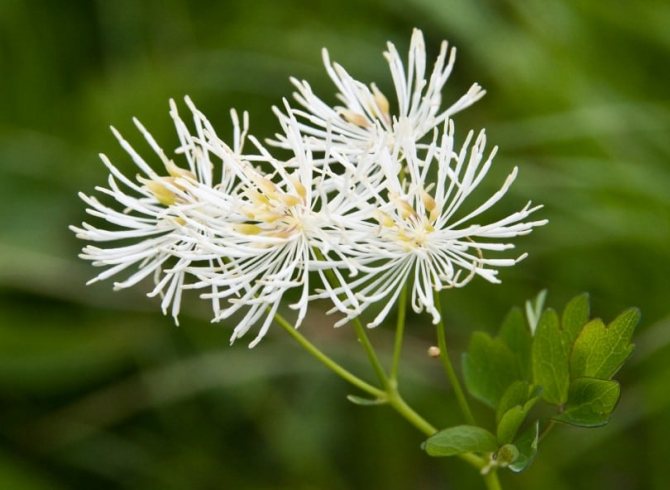

Cuttings
For this method, the best period will be spring. New shoots with unblown leaves are cut from an adult plant. For rooting to be successful, the cuttings are placed in a container of water containing growth stimulants.
After that, they are planted in the ground and daily watering is carried out. When the cuttings get stronger, they are planted in open ground, keeping a distance of 40-50 cm.
Dividing the bush
This easy breeding method will be within the power of even beginners in gardening. It is better to carry out the procedure in early spring. To do this, the bush is dug up and the root is divided into the required number of parts. Further, the compartments are planted in prepared holes and watered abundantly.
Basil in the garden
You look at the basilists, they have such an unusual appearance, it seems as if it is horror which capricious, but do not be afraid of these plants, many representatives of this genus grow well in our difficult conditions even without special care.
Genus Basil (Thalictrum) has about 150 species. The main feature of these plants, which makes them so unusual and attractive, is that their flowers are devoid of petals, and immediately after the buds and sepals open (although this does not happen in all species), stamens remain, therefore from afar, the flowers look more like fluffy balls and small tassels.
But it is not only the "cosmic" appearance of basilists that attracts gardeners - these plants are distinguished by their unpretentiousness, and they winter in central Russia without problems. They grow well on different soils, they can easily put up with even the poor, although especially bright and lush specimens still succeed in areas with fertile, moist soil.
Most often in the gardens of central Russia can be found in. water-collecting (Thalictrum aquilegiifolium), in nature it grows in the middle, southern and southwestern parts of European Russia, as well as in Asia Minor and the Balkans.
This plant is large, reaches a height of 170 cm. Its leaves are gray-gray, complex, large, reminiscent of the leaves of aquilegia, for which it got its name. The flowers are lavender, collected in a large airy panicle up to 20 cm long. They bloom in June, and abundant flowering can last for more than a month. In the garden, this species has the most place in a rarefied shade, it is better under a canopy
trees.It can grow in the light, although in this case the flowering will not be so long, and the flowers themselves will quickly fade. In addition to the specific plant, on sale you can find several of its varieties of different heights and flower colors: Thundercloud - low, up to 70 cm, deep purple flowers; snow-white ‘Album’ up to a meter high, mauve 'Dwarf Purple', As the name implies, a dwarf, up to 40 cm in height.
Another view that deserves our attention - yellow basil (Thundercloud flavum) up to 180 cm high.
The leaves of this basil have a bluish bloom, triangular in shape. The flowers are yellow, collected in large corymbose-paniculate inflorescences. They bloom in the middle of summer. But this species has one drawback - the stems cannot withstand strong winds and can lie down, therefore, in order for the plant to remain attractive, it is tied to a support or saved by a tight planting, planting next to shrubs. This species has the True Blue variety, which looks very similar to the original plant, but differs in more durable, practically non-sticking shoots.
Among the low basilists can be noted in. filamentous (Th. Filamentosum), which came to us from the Far East, in height it reaches only 20 cm, forms a loose cover. Its snow-white flowers, collected in openwork inflorescences, bloom from mid-May to mid-June. It is a resilient plant that grows well in tree trunks. Another advantage is that it is a long-liver; it grows well in one place for 20 years or more.
Description of the plant
The name of the perennial dates back to Ancient Russia: according to legend, the healer Vasilisa healed warriors with a healing decoction, and the plant was named in her honor. There are similar names - basilis, basilis grass, basilist. From Latin - thalictrum (taliktrum) - translated as "green branch" and "supplication". And the British, because of the similarity with the rue, call the flower meadow rue, or meadow rue.
Belongs to the buttercup family (in Latin - Ranunculaceae), and the closest relatives of meadow rue are anemone, catchment, delphinium and clematis. In its natural environment, the plant comes across in Russia, Europe, North America, South Africa.
In total, there are 150 varieties in the genus, which have general characteristics. These are perennials, in height from 5 cm to 2 m. The stems are bare, foliage is collected at the base of the stem. Leaves are common and feathery. The flowers add picturesqueness to the plant, picked up in dense or loose inflorescences in bunches or panicles. When the flowers have faded, fruits are born in the form of an intricate multi-root.


